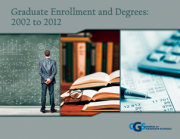You are on CGS' Legacy Site.
Thank you for visiting CGS! You are currently using CGS' legacy site, which is no longer supported. For up-to-date information, including publications purchasing and meeting information, please visit cgsnet.org.

Domestic Enrollment Still a Concern, Especially in STEM Fields
Contact:
Julia Kent
jkent@cgs.nche.edu
(202) 223-3791
Washington, DC — The Council of Graduate Schools (CGS) reported today a 1.8% increase in first-time enrollment between fall 2011 and fall 2012. More than 461,000 students enrolled for the first time in graduate certificate, education specialist, master’s, or doctoral programs for the fall 2012, according to institutions responding to the CGS/GRE Survey of Graduate Enrollment and Degrees, an annual survey that has been conducted since 1986.
Despite the gains in first-time enrollment, total graduate enrollment fell 2.3% following a 0.8% decline in the previous year. Total graduate enrollment was nearly 1.74 million students in fall 2012.
Institutions responding to the survey received nearly 1.98 million applications for admission to fall 2012 graduate programs. Applications rose 3.9% between fall 2011 and fall 2012. The overall acceptance rate was slightly lower than the previous year, with 39.5% of applications resulting in offers of admission for fall 2012. As CGS also reported last year, the fact that first-time enrollment trends have not matched the growth in applications may be a sign that many qualified students who wish to attend graduate school are faced with obstacles to enrolling.
First-time graduate enrollment of temporary residents increased 8% between fall 2011 and fall 2012, according to survey respondents, up slightly from the 7.8% increase in fall 2011. In contrast, the growth in first-time graduate enrollment for U.S. citizens and permanent residents between fall 2011 and fall 2012 was essentially stagnant at 0.6%. In fall 2012, more than one-half (54.7%) of all temporary resident graduate students were enrolled in engineering, mathematics and computer sciences, physical and earth sciences, or biological and agricultural sciences. Only 17.3% of U.S. citizens/permanent residents were enrolled in these fields.
CGS President Debra W. Stewart viewed the data for first-time graduate enrollment with cautious optimism. “It’s certainly good news that the number of new students enrolling in U.S. graduate programs is trending upward. However the trend must accelerate if we are to gain ground against previous losses.” Stewart added that this is particularly the case for domestic students. “An increase of less than one percent in first-time enrollment for domestic students is worrisome given that the U.S. economy will have an increasing need for highly-skilled talent in order to thrive. Our country must do more to address the economic factors, like student debt, that discourage many students from enrolling in U.S. graduate programs.”
One piece of encouraging news contained in the report is that first-time enrollment for underrepresented minorities has increased. Among survey respondents, first-time graduate enrollment rose 7.4% for Hispanic/Latinos, 5.7% for American Indians/Alaska Natives, and 4.6% for Blacks/African Americans between fall 2011 and fall 2012.
Other report findings include:
Trends by field
- The largest one-year changes in graduate applications between fall 2011 and fall 2012 occurred in mathematics and computer sciences (11.1%), health sciences (9.6%), and engineering (9.3%).
- Applications to graduate programs in business rose 0.7% between fall 2011 and fall 2012, much slower than the 4.3% growth in the previous year.
- First-time enrollment in education programs grew 2.5% for fall 2012, compared to a sharp drop of 8.8% in fall 2011.
- The largest fields by total enrollment were education and business, respectively accounting for 20% and 16% of total graduate enrollment at responding institutions in fall 2012.
Trends by degree level
- About 74% of all graduate students in fall 2012 were enrolled in programs leading to a master’s degree or a graduate certificate, according to survey respondents.
- Responding institutions awarded approximately 67,200 doctoral degrees, 540,000 master’s degrees, and 31,900 graduate certificates in 2011-12.
- Between fall 2011 and fall 2012, first-time enrollment increased by 5.0% at the doctoral level and 1.2% at the master’s level.
Student demographics
- About 58% of all first-time graduate students in fall 2012 were women, according to survey respondents.
- According to survey respondents, women earned nearly two-thirds of the graduate certificates, 60% of the master’s degrees, and 52% of the doctorates. Academic year 2011-12 marked the fourth straight year women earned a majority of doctoral degrees.
- Over the 2011-2012 period, first-time enrollment for Whites fell by 0.9%.
About the report
Graduate Enrollment and Degrees: 2002 to 2012 presents the findings of an annual survey of U.S. graduate schools, co-sponsored by CGS and the Graduate Record Examinations (GRE) Board. It is the only annual national survey that covers enrollment in all fields of graduate study and is the only source of national data on graduate applications. The report includes responses from 675 institutions, which collectively confer about 73% of the master’s degrees and 91% of the doctorates awarded each year. The survey report presents statistics on graduate applications and enrollment for fall 2012, degrees conferred in 2011-12, and trend data for one-, five- and ten-year periods.
The Council of Graduate Schools (CGS) is an organization of over 500 institutions of higher education in the United States and Canada engaged in graduate education, research, and the preparation of candidates for advanced degrees. Among U.S. institutions, CGS members award 92% of the doctoral degrees and 78% of the master’s degrees.* The organization’s mission is to improve and advance graduate education, which it accomplishes through advocacy in the federal policy arena, research, and the development and dissemination of best practices.
* Based on data from the 2012 CGS/GRE Survey of Graduate Enrollment and Degrees




